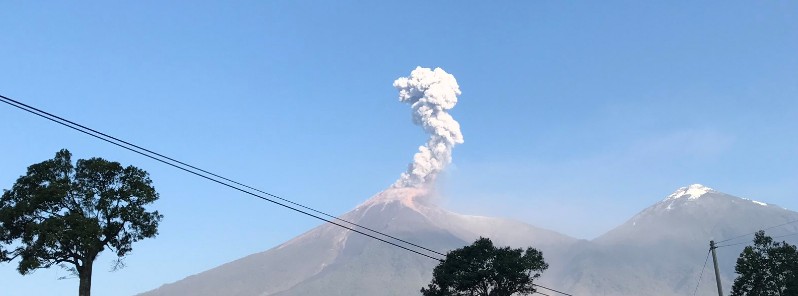Increased activity at Fuego volcano, Guatemala

Guatemalan Fuego volcano is exhibiting increased activity today, prompting authorities to restrict access to the volcano.
In a special bulletin released April 21, 2017, INSIVUMEH reported an average of 5 to 7 weak to moderate explosions per hour which generate a plume of ash reaching an approximate height of 4.6 – 4.9 km (15 092 – 16 076 feet) above sea level.
The plume is traveling more than 20 km (12.4 miles) to the east, northeast, and southeast. Additionally, the volcano is ejecting incandescent material of various sizes to a height of about 150 to 300 meters (up to 1 000 feet) above the crater which is reaching distances of more than 200 meters (650 feet). Some of the explosions are generating moderate avalanches in the area of the cone.
INSIVUMEH warned tourist agencies and tourists not to approach the volcano.
Fuego is a stratovolcano in the Central American volcanic arc that erupts crystal-rich lavas of basalt to basaltic-andesite composition. It has been continuously active since 1999.
@ClimaenGuate @prensa_libre @Guatevision_tv Los colosos #Fuego y #Acatenango pic.twitter.com/FzITOW3Xv7
— KennyMauricio Loaisa (@KensoGT) April 21, 2017
A spectacular view from Common Hope this morning! The top of #Acatenango was covered in snow while #Fuego sent puffs of smoke into the air. pic.twitter.com/jQE5F4jo7E
— Common Hope (@commonhope) April 21, 2017
#volcan #volcano #Fuego Wow: très belle explosion à l'instant!/Very impressive explosion right now! pic.twitter.com/kluCGplJ8T
— CultureVolcan (@CultureVolcan) April 21, 2017
Geological summary
Volcán Fuego, one of Central America's most active volcanoes, is one of three large stratovolcanoes overlooking Guatemala's former capital, Antigua. The scarp of an older edifice, Meseta, lies between 3 763 m (12 345.8 feet high Fuego and its twin volcano to the north, Acatenango. Construction of Meseta dates back to about 230 000 years and continued until the late Pleistocene or early Holocene. The collapse of Meseta may have produced the massive Escuintla debris-avalanche deposit, which extends about 50 km (31 miles) onto the Pacific coastal plain.
Growth of the modern Fuego volcano followed, continuing the southward migration of volcanism that began at Acatenango. In contrast to the mostly andesitic Acatenango, eruptions at Fuego have become more mafic with time, and most historical activity has produced basaltic rocks. Frequent vigorous historical eruptions have been recorded since the onset of the Spanish era in 1524, and have produced major ashfalls, along with occasional pyroclastic flows and lava flows. (GVP)
Featured image credit: Kenny Mauricio Loaisa

Commenting rules and guidelines
We value the thoughts and opinions of our readers and welcome healthy discussions on our website. In order to maintain a respectful and positive community, we ask that all commenters follow these rules.